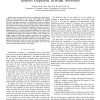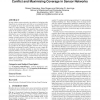561 search results - page 45 / 113 » Small-world effects in wireless agent sensor networks |
MOBIHOC
2009
ACM
14 years 8 months ago
2009
ACM
Location-free boundary recognition is crucial and critical for many fundamental network functionalities in wireless ad hoc and sensor networks. Previous designs, often coarse-grai...
COMCOM
2010
13 years 7 months ago
2010
For data-collection applications in sensor networks, it is important to ensure base station receives a complete picture about the monitored area. Convergecast is an important commu...
INFOCOM
2008
IEEE
14 years 2 months ago
2008
IEEE
Abstract—In road networks, sensors are deployed sparsely (hundreds of meters apart) to save costs. This makes the existing localization solutions based on the ranging be ineffect...
VTC
2006
IEEE
14 years 1 months ago
2006
IEEE
– Simple algorithms have been developed in the area of node localization in a wireless sensor network. For these simple algorithms to work, several assumptions were made. However...
ATAL
2010
Springer
13 years 8 months ago
2010
Springer
In large wireless sensor networks, the problem of assigning radio frequencies to sensing agents such that no two connected sensors are assigned the same value (and will thus inter...


